Tonopah is a small community with a population of about 2,600. Tonopah is located at the junction of U.S. Routes 6 and 95 approximately half-way… (click the photo for more information on Tonopah)
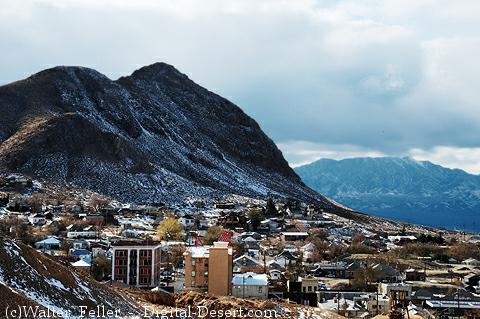
The Whole Mojave A-Z
The Mojave High Desert is one desert rather than a series of separate entities- That we are the same through the diversity that binds us. By becoming aware of our combined identity, we may be able to appreciate, and better understand issues affecting our Mojave Desert on a holistic level. In this presentation we meander back and forth across the Mojave Desert in photographs to illustrate this concept.
By MARY BEAL
Nearly every desert visitor knows Evening Primrose—but not all of them know that the white-ribbed “baskets” so often found rooted in the sand are the dried stalks of this lovely white flower which blossoms at night and takes a siesta when the sun comes out….Continued Here
Hard Rock Shorty of Death Valley
“This place must be a great deal like the Sahara desert,” remarked one of the tourists who had stopped at the Inferno store to ask about the location of Death Valley Scotty’s mine.
“Do you ever see any ostriches or camels wandering around over these barren sand dunes?”
“Not any more,” said Hard Rock Shorty. “Usta be some ostriches here, but Ol’ Pisgah Bill got rid of ’em. They wuz too dumb to do any work, an’ they kept eatin’ up his grub. He finally gave ’em all to the zoo down in Los Angeles.
“Bill had a good idea—only it didn’t work. It was back in the old days when the wimen wuz all wearin’ ostrich plumes on their hats. Ostrich farms wuz springin’ up everywhere. Bill read in the papers about a big ostrich ranch down in Phoenix which sold $60,000 worth of feathers in one year.
“So Bill sent to the gov’ment printin’ office an’ got all the information he could about ostriches. The more he read the more certain he was that them big birds ‘d thrive in Death Valley. ‘They eat anything,’ he explained, ‘an’ they don’t drink much water. Death Valley’s just the place fer ostriches.’
“The next winter Bill hit a purty good pocket in that gold mine o’ his over in the Panamints, an’ as soon as he got his returns from the mill he sent down to Phoenix to buy a couple o’ them ostriches.
“Bill’s idea wuz to make ’em work fer a livin’. He’d train ’em to pack out ore like a burro, an’ when pluckin’ time came he’d gather a few feathers—and that would be an extra bit o’ profit.
“Trouble wuz, them ostriches did jes what all the books said they’d do—they ate everything. Second morning after Bill got ’em into camp up in Eight Ball crick one o’ them big birds stuck his head in the window o’ Bill’s little shack an’ swallered Bill’s can o’ coffee. The other bird saw what wuz goin’ on and it reached in an’ took the coffee pot in one gulp. Bill had to keep the house locked, the windows closed, and all his tools out o’ sight, cause them birds jest gobbled up everything layin’ around.
“An’ to make it worse, the only way Pisgah could get ’em to pack rock wuz to walk ahead of them carryin’ something to eat. They wuz too dumb to learn, an’ the burros didn’t like ’em either.
“The final showdown came one mornin’ when one of them ostriches walked into the mine tunnel and swallered three sticks o’ dynamite. As it came out it passed close to one of the burros, and the animal hauled off an’ gave it a kick. The explosion killed the burro, blew down the shack, an’ the bird was sick fer a week. That wuz the last straw. Bill gave the ostriches to the zoo.”
~ from Desert Magazine – June 1958
— As I write this it’s late, but not too late, so I can still say it was this morning’s sunrise breakfast. The menu consisted of a broken pop tart, a beef stick and two or three sips of ice cold water. I had eaten my banana in the car while driving across the valley in the dark; I washed it down with half a cup of lukewarm coffee. The service, self-service, was horrific. I think/hope it was a stick that somehow mixed in with my cinnamon toaster pastry. I sat on a rock that was a little too tall and had a slightly uncomfortable lump in an odd place. The tops of my ears were cold and I couldn’t feel the end of my pointy little nose. All things considered, the view, lighting and overall ambiance was sublime. I rate this breakfast spot 3 out of four stars and will be returning in the warmer weather.
I went to throw myself into the desert sea;
to find isolation and solitude between the swells of the earth
and shifting light.
Day to night, and night, and night as it echoes beyond the evening,
the storm calmed.
At critical mass, the moon then shifted the tide . . .
and the understructure,
the secret work in preparation for the next day had begun.
Sometimes when it is so pretty in the desert you just have to veer off the side of the road, slam on the brakes, raise a cloud of dust, get out of the car and just stare at how pretty it is.
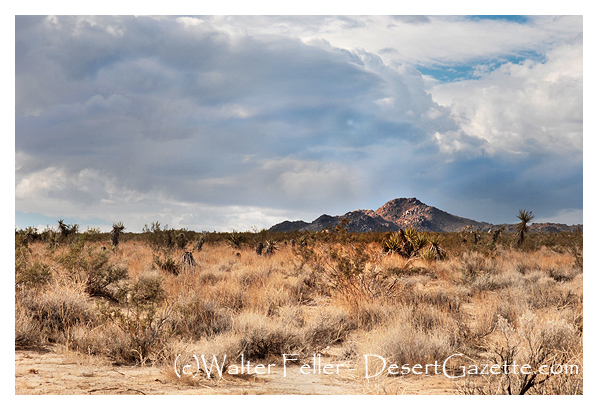
The creosote bush is truly the unnoticed elephant in the room. If someone were to weigh the biomass of the desert Southwest, this species would certainly possess the highest percentage of life and we would find that a high percentage of all other life in the desert is dependent upon it, yet its importance in the desert environment goes unappreciated by both scientists and artists alike. …
New Pages to Digital-Desert.com
Updates to MojaveDesert.Net
There are quite a few more changes in progress and somewhat hidden from view. I’ll post them as soon as they are ready.
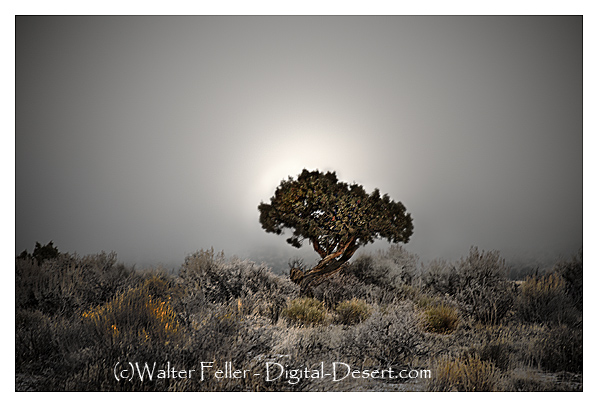 An early morning in the high pass between the Providence and New York mountain ranges is a good place to watch for fog. Not fog as how we think of fog in a normal sense, but fog as when clouds roll over this pass. Bitter and brutally cold in the winter, strafing the ground with a crust of frost the clouds lay down and pick up as fast as they leave. Of course the wind moves it all, and not a gentle wind either. This is a wind so icy it twists one’s soul as it blows through. It is all worth it though–a different kind of solitude–you were the only one to see it and feel it.
An early morning in the high pass between the Providence and New York mountain ranges is a good place to watch for fog. Not fog as how we think of fog in a normal sense, but fog as when clouds roll over this pass. Bitter and brutally cold in the winter, strafing the ground with a crust of frost the clouds lay down and pick up as fast as they leave. Of course the wind moves it all, and not a gentle wind either. This is a wind so icy it twists one’s soul as it blows through. It is all worth it though–a different kind of solitude–you were the only one to see it and feel it.
Sometimes the genesis of a spring may not look like much because it may not be much. The beginning point of a spring can be just a beginning, a wet spot with a little greenery and some crusty dried vegetation around it.
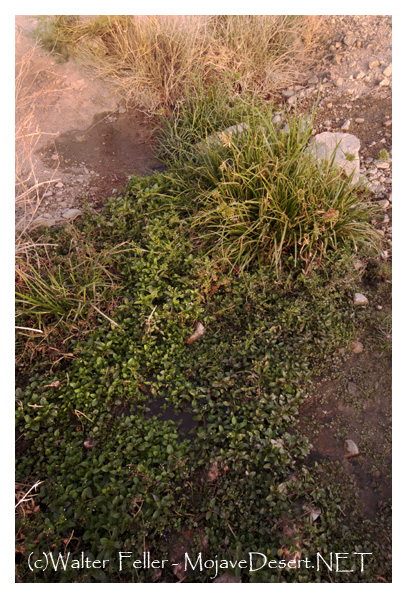
Both pages in this update are out of the Mojave, but were essential to the Mojave as destinations and bases of operation.
Mission San Gabriel
The mission was the destination for early explorers, trappers, and traders to southern California.
San Bernardino, California
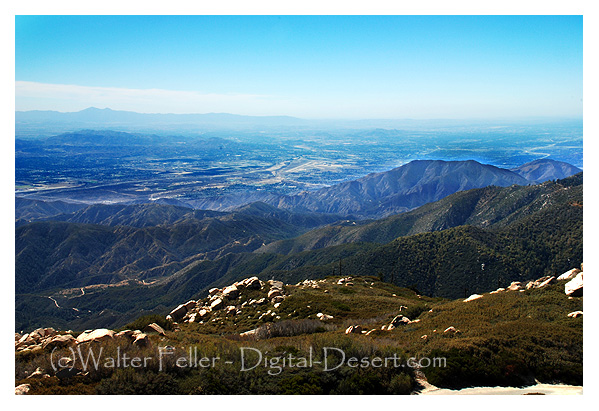
Initially starting as an “Astencia” or outpost to the San Gabriel mission, Mormons purchased the land from The Lugo brothers and turned it into a stronghold and ultimately into the gateway to southern California.
With the completion of the text in Pioneer of the Mojave by Richard Thompson, I’ve been going through and putting in links and back links. One page I’ve finally got around to making is a page about Point of Rocks, a stop along the Mormon trail near where Helendale is today.
Quite a pretty bird, one I had probably seen before, but never really paid attention to. These were in the Saline Valley, one of the most remote and difficult-to-access locations in Death Valley National Park. These birds stand out to me now because someone I talked to said that these birds wandered in during a wet spring and never left; that it was too far to the next body of water that was livable for them, and ultimately, they just began to live here throughout the year. I know better now, however, there is no sense in throwing a good story like that away.
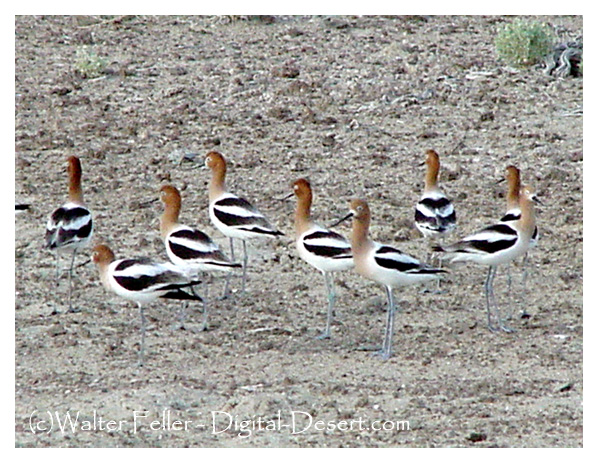
For a few months in 1883 when the Southern Pacific Railroad was being built, the Watson post office lived out its short tenure. Watson was named Watson for Josiah Watson who was the postmaster. When the Watson post office closed the railroad named their station Newberry. For a few months in 1899, the Newberry post office was reestablished then discontinued. In 1911 the post office reopened and was named Wagner after Madge Wagner who ran it. In July of 1919, the name was changed from Wagner to Water, who wasn’t a person but was named for the water that was pumped out of the ground for the Sante Fe Railroad’s use. Then, years later in 1967, the name was changed from Water to Newberry Springs. No one is quite certain who Newberry was, to begin with, but it could either be for either one or both of two brothers named Newberry who lived near the springs, of which one was killed in a gunfight over water rights to the springs and ended up being buried on top of a hill not far from the springs. Or the name of the springs came from Dr. J.S. Newberry, a physician in the 1857 survey expedition led by Lt. Joseph C. Ives.
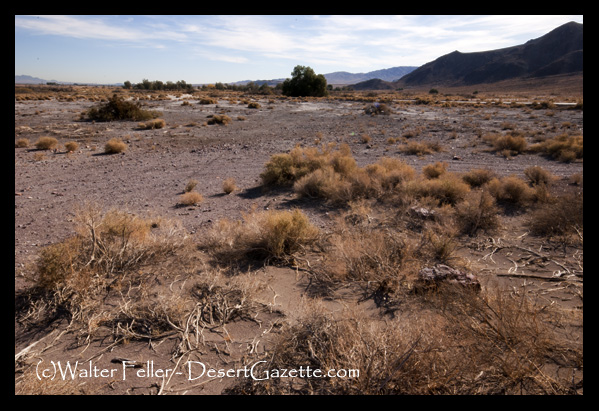
A Cousin Jack could be a cousin named Jack- But back in the 1800s it could have been a miner of Cornish, English, Irish, or Welsh origin. Another thing a cousin Jack could have been was a dugout that a miner lived in, roofed over with dirt providing insulation making it cooler in the summer and warmer in the winter.
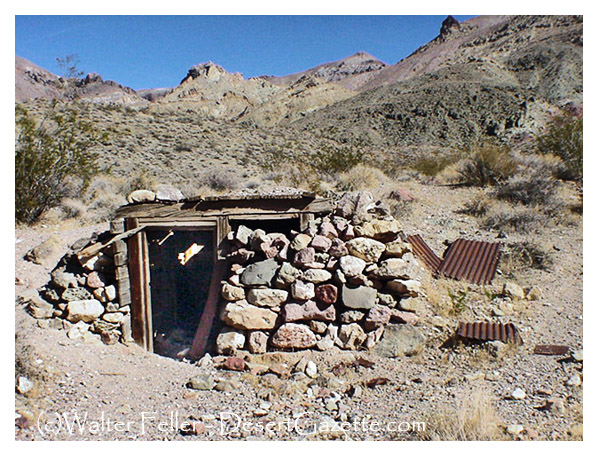
Pilot Rock, 18 miles south of Victorville, California in the San Bernardino mountain range can be seen from far out into the Mojave Desert. Pioneers on the Mormon Road would head in the general direction of the 5,260 foot high peak in order to find the Mojave River and their way into southern California.
Here is what I saw while I ate my sandwich at Zion. It was a salami sandwich. It was very good, with plenty of mustard and just a light spread of mayonnaise. My wife won’t let me put a whole lot of mayo on my sandwiches because she says it will get rotten or something and kill me. I don’t sweat it because I’ve done worse to myself and haven’t died yet. I’ve learned to do as she tells me though. It just makes things flow a little smoother–Like a little extra mayonnaise would help the sandwich go down easier.
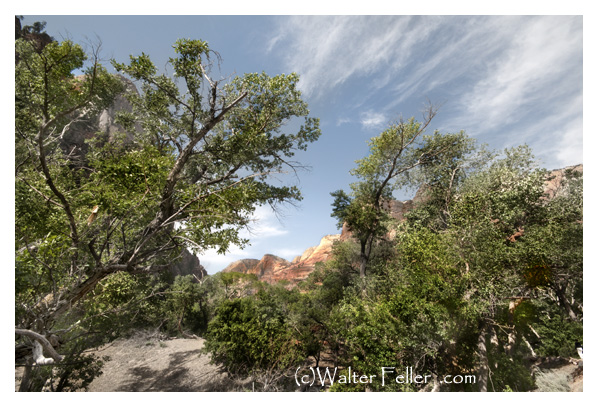
After Frank Morgan died Bill Keys ended up owning the Wall Street Mill–and I’m pretty sure that sounds exciting; a tin shack wrapped around a stamp mill, pulverizing rock and squeezing mercury from gold amalgam. What more would anyone want? He would mill ore from his Desert Queen Mine and other holdings as well as for other miners in the area. He’d charge by the ton of ore, and the mill was one of many little industries that a desert rat like Bill needed to live in the desert. Worth Bagley claimed that Bill trespassed on his property to get to the mill. Bagley didn’t like Bill a bit. One day it came to a head and Keys ended up killing Bagley in self defense. Bagley was connected to the Sheriff’s office as a former deputy, so things turned against Bill in court, and he ultimately went to prison. Bill fought and appealed, but to no avail — he even turned down parole rather than falsely admit guilt. Keys was gifted, of a sturdy sort, and he didn’t let the imprisonment tear him down. His family had to move on, though, and in many ways it was the ruination of the Keys dynasty in what is now Joshua Tree National Park.
Wall Street Mill
I’ve heard that Jim McHaney got Charlie Martin to get a man named James to sign over the Desert Queen Mine before Charlie shot and killed him. Charlie went on trial for the murder, but got off on self-defense. Charlie also was pals with the San Bernardino County Sheriff so that may have helped, and it may have helped Charlie Martin become the Chief of Police in San Bernardino once Charlie decided to settle down. However, that had nothing to do with Jim McHaney and his band of rustlers, thieves and killers running the Desert Queen into the ground after spending the investors’ money. McHaney ended up using the gold from the mine to counterfeit twenty dollar gold pieces, which after he got caught and sent to prison where he either died there or ended up sweeping streets in Riverside until he did die. Whoever did own the mine after McHaney lost it didn’t pay Bill Keys for working it, and Keys took over the claim for back wages. There was about four million of today’s dollars total in gold that came out of the mine over the 60-70 years that it was in operation. At least that’s what I heard.
A description of green cone pinon nut harvesting.
Originally titled – Role of Pinyon-Juniper Woodlands in Aboriginal Societies of the Desert West
Joel C. Janetski
Pine nuts were usually gathered in the early fall at about the time of the first frosts. Two methods were employed: green or brown cone harvesting (see Madsen 1986). The former took place before the cones opened. The green cones were either removed from branches using a hook or sometimes branches containing cones were broken off the tree. Once removed the sticky cones were placed in pits and roasted until the cones began to open. They were then pulled out of the fire with sticks, cooled, and opened, and the nuts were removed and tossed in a heap. A graphic account of pine nut harvesting by the green cone method is supplied by Howard Egan in western Nevada in the late 1800’s.
Jack and I were taking a scouting trip high up in the Schell Creek Range of mountains, when we came across an Indian who, with his [wife) and children were busily engaged gathering pine nuts. The man had a long pole with a strong hook fastened to one end. He would reach up in the tree to the pine cones, hook the crook around the branch on which they hung and pull branch and all down, the woman and children carrying them to a place and piling them up in a heap. When they had collected as many as they wanted that day, the [man) has finished his part of the work and could pass the rest of the time sleeping or hunting squirrels just as he pleased.
The women and children gathered a little dry brush which was thrown loosely over the pile of cones and set fire to. The cones are thickly covered all over with pitch, for this reason they make a hot fire, the [woman) watching and stirring it up as needed to keep the nuts from burning, as she rakes them back from the fire as a man would do when drawing charcoal.
When the pitch was all burned off the burs or cones, the [woman) spreads a blanket down close to the pile, then taking up one cone at a time, would press them end ways between her hands, which opens the leaves, under which there were two nuts to every leaf, Then shaking the cones over the blanket area the nuts would all fall out as clean as you please.
When the nuts had all been cleaned from the cones they were put in a large basket that would hold over two bushels and was nearly; full, the [woman) carrying that on her back to a place where they were placed all through the pine-nut grove to save carrying them too far and save time for the harvest does not last long, for a heavy frost will cause the cones to open and the nuts to fall to the ground (Egan 1917:241).
Somehow I got off track from the food web and started working on my bird section. It was in need of updating for sure, so I spent sometime bringing that up to speed. While I was there I decided to work on some of my favorites and see what I could do to improve the pages- Mostly just make the pictures larger.
When I first moved to the Mojave Desert I found it funny to see these at the local lakes. I thought they had been shipped in to add ambiance to the park atmosphere. I was right–They do make it nice in the parks. But they came on their own.
Bird of the Day – Canada goose
As mentioned, I’ve seen these at the local park fishing lake. They certainly aren’t as obnoxious as the domestic white geese there. They will chase you though–and chase you and chase you and chase you. At least that’s what I seen happen to a little boy trying to bully one. I’ll bet that kid doesn’t do it again.
These geese, there were a Momma, Papa, and five or six little goslings on a tiny island made of rocks in the Colorado River. There was a nice backwater flow and I went around the island several times taking pictures. Mom and Dad were concerned but not aggressive . I kept my distance and admired the little family.
I think the strangest place I’ve ever seen geese was at Saratoga Springs at the extreme southern end of Death Valley. I certainly wasn’t expecting that. Now that I know more about these beautiful creatures it doesn’t seem so odd. They were probably just taking a break on their way south.
I finally found a graphic I could use for a page on a food pyramid. I probably could have made one faster, but it was a good excuse for it putting off for a few years. The food web is a little trickier. I’ll definitely be making my own illustration for that. I seen one where someone used one of my images and did a sloppy job of it. It is a same when someone steals your work and uses it as part of something that isn’t worth stealing back. I can do better. So I will. That will come in time though.
Links:
I’m certain that these updates do not appear to be all that complex. What is interesting is the updates that spring off of these. For instance, associated words such as:
There may be a couple more- but I know for sure that there are a couple that still need to be updated.
Going through these and adding photos has been a trip. The shots come from various times and places. In these updates I used all my own photos, and even though some sots were taken of caged animals, they are geographically accurate. That means I didn’t go to a zoo out of the area to get these photos. The cougars and sometimes coyotes may look fat and spoiled, and they may well be, however, the park or zoo is geographically located in the same general environment. There are some exceptions further into the site I can think of, but not now.
I should get back to work on the food web page. It needs a graphic and some relevant information.
Virtually walk with us, virtually talk with us- Virtually together we virtually explore the unique geological features of Golden Canyon and the Red Cathedral in Death Valley National Park. Virtually.
I’ve been going through updating sections like popular pages in the glossary. I am hoping to get things uniform and reasonable to navigate.
The important thing with this update is that I’ll be blogging future updates here instead of continually editing and uploading a static page. Over the years it has become cumbersome and I tend to just let journal updates go. For now I’ve put a notice on the “Features” page redirecting to the “Updates” category here on the Desert Gazette.